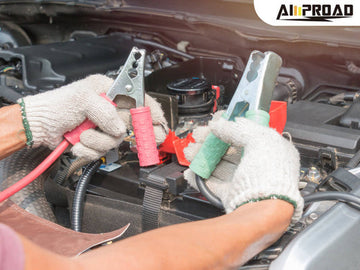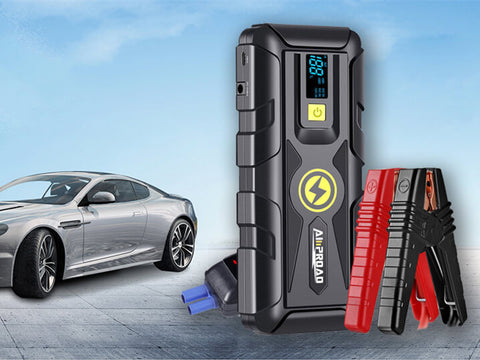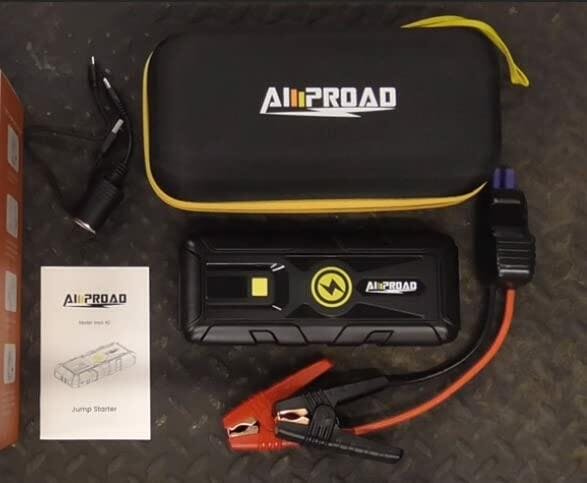
Jump-starting a diesel truck can be a lifesaver when you find yourself with a dead battery and unable to start your vehicle. Whether you're stranded on the side of the road or in a remote location, knowing how to boost a car with diesel is a valuable skill for any truck owner. However, jump-starting a diesel truck differs from jump-starting a regular gasoline-powered vehicle, requiring specific considerations and equipment.
To begin, it's essential to understand that jump-starting a diesel truck with a regular car is not recommended due to differences in battery size and power output. Diesel engines require a higher level of power to start, and attempting to use a regular car's battery for jump-starting may not provide sufficient power, leading to potential damage to both vehicles. Instead, it's advisable to use a similar-sized or larger vehicle equipped with a compatible battery or a dedicated jump starter designed for diesel engines. By following the correct procedures and using the appropriate equipment, you can safely jump start your diesel truck and get back on the road in no time. The easiest way to jump-start a diesel truck is by using a portable jump starter. For reliable performance and powerful boosting capabilities, choose the AMPROAD iRock40 jump start pack.
Can You Jump Start a Diesel Truck with a Regular Car?
Jump-starting a diesel truck with a regular car is a common question among vehicle owners facing battery issues. While it's theoretically possible to use a regular car for jump-starting, it's not recommended due to several factors. One primary concern is compatibility between diesel trucks and regular car batteries. Diesel engines typically have larger and more powerful batteries than gasoline engines to provide the high cranking amps required to start the engine. Using a regular car's battery may not deliver enough power to effectively jump start a diesel truck, leading to unsuccessful attempts and potential damage to the vehicle's electrical system.
Moreover, there are significant risks and limitations associated with using a regular car for jump starting a diesel truck. The differences in battery size and power output between diesel trucks and regular cars can result in insufficient power delivery, prolonging the time needed to start the diesel engine or causing damage to both vehicles' electrical systems. Additionally, diesel engines require more power to overcome the compression ratio and start, making them more challenging to jump-start than gasoline engines. Attempting to jump-start a diesel truck with a regular car may also void warranties or insurance coverage in case of damage, further highlighting the importance of using appropriate equipment for jump-starting diesel vehicles. Overall, while it may be tempting to use whatever is available in an emergency, it's essential to prioritize safety and avoid using a regular car for jump-starting a diesel truck to prevent potential damage and ensure a successful jump-starting process.

Can You Jump Start the Diesel Truck with a Portable Jump Starter?
Yes, you can jump-start a diesel truck with a portable jump starter, and it's often the preferred method due to its convenience and effectiveness. Portable jump starters are specifically designed to deliver the high cranking amps required by diesel engines, making them a reliable solution for jump-starting diesel trucks. These compact devices contain powerful batteries capable of delivering the necessary power to start a diesel engine, eliminating the need for a secondary vehicle or external power source.
Using a portable jump starter for jump-starting a diesel truck offers several advantages. Firstly, portable jump starters are compact and lightweight, making them easy to carry and store in your vehicle for emergencies. They also eliminate the need for another vehicle to provide the jump-starting power, which can be particularly helpful if you're stranded in a remote location with no access to other vehicles. Additionally, portable jump starters typically include safety features such as reverse polarity protection and overload protection, reducing the risk of damage to your vehicle's electrical system during the jump-starting process. Overall, using a portable jump starter is a convenient and reliable method for jump-starting a diesel truck, providing peace of mind and ensuring you're prepared for unexpected battery issues on the road.
The Amproad portable jump starter offers an impressive 4,000 peak cranking amps, making it a powerful solution for jump-starting vehicles with engines up to 10.0 liters in both gasoline and diesel variants. Its robust capabilities ensure reliable starting performance, even in challenging conditions. Beyond jump-starting capabilities, this portable device serves as a versatile 24000mAh charger for electronic devices, providing convenient power backup for smartphones, tablets, and other gadgets while on the go. With its compact and portable design, the Amproad jump starter is a practical addition to any vehicle emergency kit, offering peace of mind and ensuring you're prepared for unexpected battery issues and power needs wherever your travels take you.
What Equipment Do You Need for Jump Starting?
Jump-starting a diesel truck requires specific tools and equipment to ensure a safe and successful process. Essential items include a reliable portable jump starter with sufficient cranking amps to start a diesel engine, such as the Amproad portable jump starter with its impressive 4,000 peak cranking amps capability. Additionally, having a set of high-quality jumper cables is crucial for establishing a connection between the jump starter and the truck's battery terminals. Opt for heavy-duty jumper cables with adequate length and thickness to handle the high current flow required for jump-starting diesel engines effectively. Furthermore, it's essential to wear appropriate safety gear, such as gloves and safety glasses, to protect against accidental electrical shocks and battery acid exposure during the jump-starting process.
Proper equipment ensures a safe and efficient jump-starting process, minimizing the risk of damage to the vehicle and ensuring the well-being of those involved. Investing in reliable jumper cables and safety gear is essential for preventing accidents and injuries while jump-starting a diesel truck. By having the necessary tools and equipment readily available in your vehicle emergency kit, you can confidently handle battery issues and ensure you're prepared for unexpected situations on the road.
Where Do You Connect the Jumper Cables?
When jump-starting a diesel truck, it's crucial to connect the jumper cables correctly to ensure a safe and effective process. Start by identifying the positive and negative terminals on both the donor vehicle's battery and the dead battery in the diesel truck. The positive terminal is typically marked with a plus sign (+), while the negative terminal is marked with a minus sign (-). Once identified, connect one end of the positive (red) jumper cable to the positive terminal of the donor vehicle's battery and the other end to the positive terminal of the dead battery in the diesel truck. Next, connect one end of the negative (black) jumper cable to the negative terminal of the donor vehicle's battery and the other end to a clean, unpainted metal surface on the engine block or chassis of the diesel truck, away from the battery and fuel system components. This grounding point helps minimize the risk of sparks and potential damage to the vehicle's electrical system during the jump-starting process.
Connecting the jumper cables to specific terminals and grounding points is essential to avoid damage to the vehicles involved. Improper connections can lead to electrical overload, which may cause damage to sensitive electronic components or even result in injury to those handling the cables. Additionally, it's important to ensure that the jumper cables are securely attached to the battery terminals and grounding point to maintain a reliable electrical connection throughout the jump-starting process. By following the correct procedure for connecting jumper cables, you can minimize risks and ensure a safe and successful jump start for your diesel truck.
How Do You Perform the Jump Start?
Performing a jump start on a diesel truck requires a systematic approach to ensure safety and effectiveness. Begin by positioning the donor vehicle close enough to the diesel truck so that the jumper cables can reach both vehicles' batteries comfortably. Turn off the ignition and all electrical accessories in both vehicles to prevent any electrical surges during the jump-starting process. Next, follow the correct procedure for connecting the jumper cables, ensuring that the connections are secure and free from corrosion or dirt that may hinder conductivity. Once the cables are properly connected, start the engine of the donor vehicle and allow it to run for a few minutes to charge the battery and build up power.
After allowing the donor vehicle to run for a brief period, attempt to start the diesel truck's engine. If the engine fails to start initially, wait a few more minutes to allow the battery to receive additional charge from the donor vehicle. Avoid excessive cranking of the engine, as this may cause further damage to the battery or electrical system. Once the diesel truck's engine starts successfully, carefully disconnect the jumper cables in the reverse order of connection, starting with the negative cable attached to the grounding point. Be mindful of any sparks that may occur during cable disconnection and ensure that the cables do not come into contact with each other or any metal surfaces to prevent electrical hazards.
To ensure a successful jump start and avoid common mistakes, it's essential to follow the correct procedure carefully. Remember to keep safety in mind at all times and wear appropriate protective gear, such as gloves and safety glasses, when handling jumper cables and electrical components. Additionally, avoid attempting to jump-start a diesel truck alone if possible, as having an extra set of hands can be helpful for ensuring a smooth and safe jump-starting process. By following these tips and procedures, you can confidently perform a jump start on your diesel truck and get back on the road quickly and safely.
Can You Jump Start a Diesel Truck Alone?
Jump-starting a diesel truck alone is possible but may present challenges due to the heavy-duty nature of diesel engines and the physical demands of the jump-starting process. While it's technically feasible to connect the jumper cables and attempt to start the diesel truck's engine without assistance, solo jump-start attempts can be more challenging and may require additional precautions. One consideration is the physical strength required to handle the heavy jumper cables and make secure connections to the battery terminals, especially in adverse weather conditions or tight spaces. Additionally, solo jump-start attempts may be more time-consuming and may require more patience and persistence to achieve a successful start, as there is no one available to assist with troubleshooting or providing additional support during the process.
Despite the challenges, there are alternative options and precautions that individuals can take for solo jump-start attempts. Using portable jump starters with sufficient cranking amps, such as the Amproad portable jump starter, eliminates the need for a secondary vehicle and provides a convenient and reliable solution for jump-starting a diesel truck alone. Additionally, taking extra precautions, such as wearing protective gear and ensuring a stable and safe working environment, can help mitigate potential risks and ensure a successful jump-starting process. While solo jump-start attempts may require more effort and caution, they can be accomplished with proper preparation and attention to safety, providing a valuable skill for diesel truck owners facing unexpected battery issues on the road.

What Are the Common Mistakes to Avoid?
Common mistakes during diesel truck jump-starting can lead to inefficiencies, potential damage to vehicles, and even personal injury. One common error is incorrect cable connections, such as attaching the jumper cables to the wrong terminals or connecting them in the wrong order. This can result in electrical damage to the vehicles' systems or even pose a safety hazard due to sparks or electrical shocks. Another frequent mistake is attempting to jump-start a severely depleted battery without first charging it properly, which can strain the donor vehicle's battery and may lead to unsuccessful jump start attempts. Additionally, leaving the vehicles running during cable disconnection or failing to secure the cables properly can result in accidental damage or injury.
To avoid these common mistakes and ensure a successful jump start, it's essential to follow the correct procedure carefully and pay attention to detail. Double-check cable connections to ensure they are secure and correctly attached to the battery terminals. Follow the recommended order of connection and disconnection to minimize the risk of electrical damage or injury. Additionally, consider using a portable jump starter for added convenience and reliability, especially in situations where assistance may not be readily available. By taking these precautions and avoiding common errors, you can confidently jump-start your diesel truck and address battery issues effectively while minimizing risks and ensuring safety for yourself and your vehicle.
Safely Jump-Starting Your Diesel Truck:
Safely jump-starting a diesel truck requires proper equipment, careful procedure, and caution to avoid potential risks and ensure success. It's crucial to have the right tools on hand, including a reliable portable jump starter with sufficient cranking amps and heavy-duty jumper cables. Follow the correct procedure for connecting the jumper cables, ensuring secure connections and proper grounding to minimize the risk of electrical damage or injury. Additionally, wear appropriate safety gear, such as gloves and safety glasses, to protect against accidental electrical shocks and battery acid exposure. By prioritizing safety and following the recommended steps, you can confidently address battery issues and safely jump-start your diesel truck whenever needed. Remember to always exercise caution and seek professional assistance if you're unsure or uncomfortable with the jump-starting process, and never hesitate to prioritize safety above all else. With proper preparation and attention to safety, you can ensure a smooth and successful jump-starting experience for your diesel truck, allowing you to get back on the road quickly and safely.




